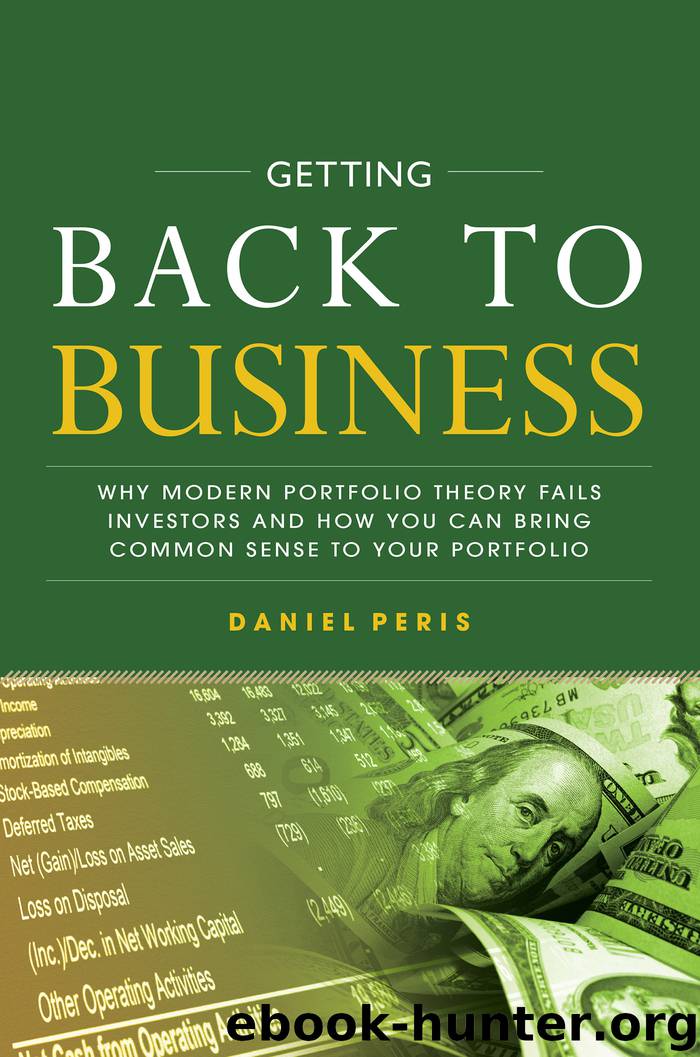Getting Back to Business by Daniel Peris

Author:Daniel Peris
Language: eng
Format: epub
Publisher: McGraw-Hill Education
Published: 2018-12-10T16:00:00+00:00
Tools: How’s the Torpedo? Where Are You in the Box?
Having the ability and the computer power to analyze quantitatively current portfolios and possible future ones was a key hurdle to be cleared before MPT could be implemented in the marketplace. While the computers were being provided by IBM and its mainframe peers of the time, the analytics came from academics such as Barr Rosenberg, a Berkeley-based professor who in the 1970s and 1980s developed the “factor” analysis that is now regularly used to parse and judge the performance of mutual funds and individual portfolios, as well as pension funds and endowments. The goal was to understand what types of risks a portfolio was taking. But the meaning of the word “risk” was evolving. Risk in Sharpe’s early work was understood simply as exposure to the overall market (beta). Sharpe’s CAPM provided a basic analytical and predictive framework based on one factor—the market—but little means to explain why an individual portfolio deviated from that prediction.
Rosenberg expanded the list of individual factors that might be driving portfolio outcomes and by which they could be measured. Importantly, he included factors beyond the stock market—he initially called them “extra-market covariances.”79 Rosenberg’s original model included 39 inputs such as size, sales growth, profit margins, balance sheet, etc.80 At least for a while, business had snuck back into stock market analyses. (The portfolio that I manage is regularly analyzed to determine which of 21 separate factors explain its total return performance relative to a benchmark or an index. My favorite factor is the “EPS Torpedo.” I have no idea what it is, but it sounds ominous.) More importantly, using these historical inputs, Rosenberg’s models could supposedly predict future portfolio risk and therefore help managers estimate future performance. That presumed that the factors held steady and were themselves the underlying driver of performance, not just a reflection of some other factor. Knowing for certain which factors to consider remains a challenge to this day. I read recently of one study where portfolios were analyzed by 319 factors.81 That may be more than the securities in the actual portfolio. It may or may not include the phases of the moon and the scores from the local bowling league. Is it possible to have too much information? Can having 319 separate analytical factors get in the way of owning a business and making investing decisions? I should think so if you have to spend all your time managing your factor exposure as opposed to managing your business.
The dissemination of factor analysis led quickly to the creation of a whole new generation of benchmarks by which investors and institutional consultants—a profession just coming into being to provide all these services—could evaluate portfolios. If a manager said he was a “growth” investor, how could one measure his performance without some sort of benchmark consisting of “growth” stocks? The same was true of value, large cap, small cap, etc. Russell introduced broad-based benchmarks in 1984 and added style benchmarks in the years thereafter.
Download
This site does not store any files on its server. We only index and link to content provided by other sites. Please contact the content providers to delete copyright contents if any and email us, we'll remove relevant links or contents immediately.
Rich Dad Poor Dad by Robert T. Kiyosaki(6354)
Pioneering Portfolio Management by David F. Swensen(6208)
How To Win Friends and Influence People by Dale Carnegie(4424)
The Money Culture by Michael Lewis(4050)
The Dhandho Investor by Mohnish Pabrai(3679)
The Wisdom of Finance by Mihir Desai(3625)
Liar's Poker by Michael Lewis(3350)
Fooled by Randomness: The Hidden Role of Chance in Life and in the Markets by Nassim Nicholas Taleb(3020)
The ONE Thing by Gary Keller(2991)
The Intelligent Investor by Benjamin Graham Jason Zweig(2982)
Mastering Bitcoin: Programming the Open Blockchain by Andreas M. Antonopoulos(2964)
How to Day Trade for a Living: Tools, Tactics, Money Management, Discipline and Trading Psychology by Andrew Aziz(2895)
Rich Dad Poor Dad: What The Rich Teach Their Kids About Money - That The Poor And Middle Class Do Not! by Robert T. Kiyosaki(2893)
Investing For Dummies by Eric Tyson(2878)
How to Win Friends and Influence People by Dale Carnegie(2843)
Market Wizards by Jack D. Schwager(2630)
Zero Hour by Harry S. Dent Jr. & Andrew Pancholi(2599)
How to Pay Zero Taxes, 2018 by Jeff A. Schnepper(2577)
The Psychology of Money by Morgan Housel(2526)
